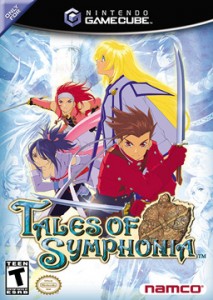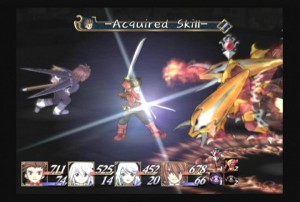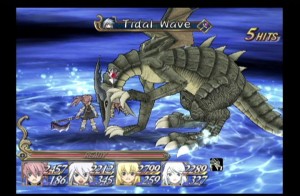
For those who are well acquainted with the Tales of series, it may be stated that their beginnings lied in this game, Tales of Symphonia, released in 2003 for the Gamecube. Tales of Symphonia introduced many to the series, and proved to be a defining moment in this game series. Unfortunately, this game shines much brighter than it should, mainly due to the nostalgia many hold for this game. This happened to be my case as well, which pushed me to replay the game to see if it really stood the test of time and a possible candidate for best game in the series.
-Story-
The story begins with Lloyd Irving, a young boy who holds a strong flame of justice in his heart. While he may not be the brightest star in the night sky, his courageousness and will to fight for his ideals really shines as a trait for the main character. Accompanying him are his best friend Genis, the Chosen Collete, great teacher Raine, and mysterious mercenary Kratos. These aren’t the only party members in the game, but to say the rest may spoil some surprises the story may hold for the player. While Lloyd and his classmates learn about the Quest of Regeneration from their teacher Raine, a light shines in the distance, signaling the start of the journey. As luck would have it, his friend Collete just happens to be this legendary Chosen, and must travel the world in order to save the world from the evil Desians that capture humans and create human ranches. While Kratos appears to guide Collete on this journey, Lloyd’s attempt to aid gets rejected, leaving him behind to wait until the journey is over. Of course, the game doesn’t end there. Due to unfortunate circumstances and dumb decisions, the two (Lloyd and Genis) are banished from the town they live in, and seek refuge with the party. This quest later turns into a twisted mess of a plot that will leave many players filled with questions; luckily, the questions are eventually answered, even if it’s near the end of the game.

The story definitely holds many plot points, and they are rather intriguing in a way. In addition, I feel Tales of Symphonia contains one of the greatest stories and character development of the entire series. However, there are many points of the story which may seem lacking, and not fully fleshed out. Some of the special twists lack that shock element that would normally be apparent, and some of the characters actions can be annoying at times. However, one factor I love about this game would be the affection system, which allows various events to vary from playthrough to playthrough, and in addition to this, there are special branches (Mainly in the beginning of the game) that allow the player to take a different path and play just a little bit different than before. These choices in variety definitely make up for the minor nuances the story may otherwise hold, and should have been carried over for future titles.
-Gameplay-
If one wanted to see where the game falls short, it would definitely be the gameplay portion of the game. While the game plays great, and adds that great battle system the series is known for, it severely lacks to newer titles. If one has played the more recent titles before playing this game, their experience will be dulled due to the lack of enhances that flourish the newer games and provide that user friendly experience. For example, the game lacks a newer ability by the title of Free Run, which allows the player to run in any direction, avoiding enemies and prioritizing strategies. I can’t tell how many times the L-Button was pressed to no avail, just because it wasn’t available in this game. Another problem would the uselessness of Magic Lens in this game. While in other games, when one uses the item to find out an enemies HP, it stays in memory for every encounter with that enemy that occurs. Such is not the case in this game, and hinders it slightly in that manor.
However, while the game doesn’t hold the enhancements given to the newer games, the battle system still gives the player a fun-filled experience full of action gameplay expected from the series. The battles are fun, traveling the world proves to be exhilarating, and the minigames give a nice breath of fresh air to the game. Just don’t expect to play the game with successful multiplayer, as the game focuses the screen on Player 1.

Outside of battle, world travel proves to be about the same as other games. There are plenty of paths to take to the next town, and battle are aplenty. Dungeons aren’t very long in this game, and to compensate for lack of space, there are many puzzles that need to be solved. Most dungeons have at least one main puzzle that results in the player running back and forth attempting to solve said puzzle, which takes up a good chuck of time.
-Sound-
The soundtrack for Tales of Symphonia is pronominal. All of the music seems to flow and fit the story in a unique and interesting way. However, most of the themes don’t appear to be as memorable as other games. While the music is good, it does tend to be a bit repetitive and doesn’t always stay at the same level of consistency. For example, I love the character themes in this game, as they fit their character design and tell the story behind said character. However, some of the more stock music doesn’t prove to be as memorable, and is easily forgettable. The battle music in this game, while good, falls to the curse of repetitive battle themes. However, this actually works in the game’s favor, as the theme gives the game more character. As for the actual theme music, which would take place in the opening cutscene before the game begins, was replaced with stock music in the American release. The original song, Starry Heavens, by the band Day after Tomorrow, fit the opening video well, and it’s a shame that it was removed in the international release.

As for character voices, I think it’s a safe bet to say that all the characters pretty much hit the mark pretty well. However, the popularity of some of the voices picked shows during the game. For example, Lloyd is played by Scott Menville; every time I hear his voice I play back Robin from the animated cartoon, Teen Titans. It is believed that this has to do with Nintendo helping with the localization project, as “union” voice actors don’t appear in future Tales series games. Either way, they do the job well, and for a long game, it’s definitely positive to have good voice actors to play the part. Unfortunately, the amount of voiced dialogue is small, as only major plot markers are voiced. Skits and small events only have text dialogue, and voices are missing from the scene. A damn shame too, as it’s hard getting used to hearing a voice then going to dead silence.
-Graphics-
One would believe that a game released in 2003 would have severely aged graphics. However, that can not be said of Tales of Symphonia. The cel-shaded look helps the games age and prevents the game from looking too blocky and outdated. Around this time, many games went for the cel-shaded look, and although it was present for many of the games at the time, it’s easy to see why that route was chosen. Most cel-shaded games don’t look that old, even by today’s standards. Of course, it doesn’t look realistic, but that’s not what the studio was aiming for, and only helps the game’s case. Unfortunately, detail is lost when this route is chosen, and some environments may look washed out or similar to another, but this situation doesn’t occur too often. Even with all the areas that this game has to offer, only some appear to be bland and boring, while others appear bright, vibrant, and beautiful.

The anime cutscenes are few and far between. While the PS2 re-release (Japanese Only) saw an addition of two cutscenes, the international version only saw four cutscenes. However, the game was released in 2003, which did hold limits on data. In addition, the cutscenes themselves were appropriately placed, with two taking place in the beginning, and two taking place at the very end. The cutscenes were beautifully animated by Production I.G, and only add to the story told by the game.
-Final Curtain-
While the game was released in 2003 and thus lacks a few prominent features, this game doesn’t fall below par and shows that it’s a game to be reckoned with. The game may be over-glorified and worshiped, there is no reason to skip out on this game. Just don’t expect a perfect game, as it’s far from it, but the game does provide a good lengthy RPG that will leave the player feeling satisfied. For that reason, I can honestly say that this game should be played by any RPG lover, regardless of the age of the game.
The sequel to this game will be reviewed next.
-Ace